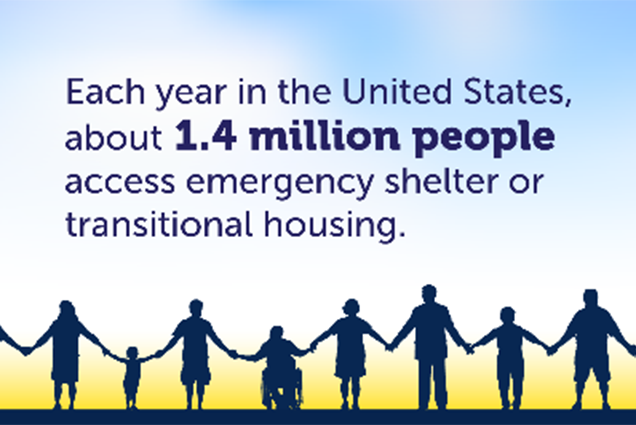Meaningful Change for Equitable Data
Teamwork results in new insights that help people experiencing homelessness or incarceration, or living with disabilities

On an average night in the United States, about 580,000 people experience homelessness. During the early days of the pandemic, homeless shelters in large cities documented COVID-19 rates of over 66%.
And the health risks are not limited to people experiencing homelessness. Other people in close living environments, such as group homes, residential treatment facilities, halfway houses, or correctional facilities, can also have a greater risk for certain health conditions and diseases, including infection during outbreaks.
A health equity mission
It can be difficult to get the data needed to understand how diseases impact people experiencing homelessness, people experiencing incarceration, or people with disabilities.
Addressing this challenge is a singular mission for epidemiologist Kristie Clarke and her colleagues in CDC’s Public Health Informatics Office. Working alongside the Special Populations Team in CDC’s Office of Readiness and Response and experts in the National Center on Birth Defects and Developmental Disabilities, the team aims to improve the data standards and data systems that are used to collect information on social determinants of health (SDOH).
“We have to think about the people who were overlooked in the original design of data systems,” Clarke says. “Health equity should not be an afterthought; it should be integrated from concept to finish. Only then will we be able to get the answers our communities need and deserve.”
People experiencing homelessness
When a person’s housing status is uncertain and results in homelessness, their health and well-being can suffer. But data on housing is often not included or is collected inconsistently in surveillance systems and in clinical electronic health record systems.
The project team is currently working to identify strategies to capture housing status, prior history of homelessness, and transitions out of homelessness in electronic health records, electronic case reporting, and surveillance systems. During the pandemic, CDC partnered with the National Healthcare for the Homeless Council to crowdsource data from clinics and create a co-branded, web-based dashboard to help fill in some of the existing gaps. The team is now in the process of launching a pilot project to help calculate the vaccination rate among people currently experiencing homelessness, and they will work closely with jurisdictions to link homeless management information systems to immunization information systems.

A health equity mission
Work is ongoing to understand how housing and homelessness status are currently captured at the local, state, and federal levels; to look at how the data are stored in different systems; and to deepen partnerships with public health and clinical care providers to include more perspectives on the data.
An important longer-term goal is the adoption of housing status or living situation as a data element in the United States Core Data for Interoperability (USCDI). By providing a common core of standardized data elements, USCDI makes mission-critical data more consistent, compatible, and usable for public health purposes.
People experiencing incarceration
Because people experiencing incarceration have fewer options for social distancing, infectious diseases can spread quickly. “In the early days of the pandemic, by the time we knew about an outbreak, the attack rate might be as high as 70%,” says Clarke.
People experiencing incarceration may also have worse outcomes when they do get sick. A study that looked at discharge records from more than 800 hospital emergency department visits found that, compared with the general population, people experiencing incarceration had higher rates of hospitalization and readmission to hospitals, invasive mechanical ventilation, and death.
These challenges underscore the need for better connection between correctional health data and public health data. During the pandemic, CDC stood up an innovative partnership with UCLA School of Law to use “web scraping” to find data on how people experiencing incarceration were impacted by COVID-19. At first, the data were collected by hand and then later automated. However, the data are often incomplete. CDC scientists are now directing a landscape analysis to uncover gaps in how data are linked between correctional settings and public health, and they plan to act on their findings by conducting a demonstration project of innovative strategies for linking these important data.
People living with disabilities
During the pandemic, the nation needed to understand the unique health needs and outcomes for people living with different types of disabilities. However, this information was not being captured consistently by healthcare or social services providers, which hindered the ability to understand how health threats impact people with disabilities.
To make up for the missing data, CDC’s data experts developed ways to use medical diagnosis codes as a proxy. The resulting analysis revealed some important findings — for example, people with disabilities are more likely to need mechanical ventilation, stay longer at (or be readmitted to) a hospital, and end up moving to a skilled nursing facility following their illnesses.
Then, in July 2022, a close collaboration between CDC and its partners resulted in meaningful change, when disability status was officially included as part of USCDI. While not yet in practice, this change represents an important step toward ensuring the data researchers, health communicators, and public health practitioners need are accessible and can fuel action more easily — both in emergencies such as COVID and for everyday threats, such as type 2 diabetes, pneumonia, heart disease, and injuries.
Inclusion in USCDI provides a path forward that may help address some of the longstanding challenges in delivering personalized services and developing data-driven responses for people with disabilities. It means that people with disabilities can be included in public health interventions from “concept to finish,” the same as other population groups.
Implementation of these standards and other changes are key steps to getting the most out of this teamwork across the agency. If this is done effectively, says Clarke, “It means the data will be there for the future.”